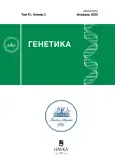Изменение содержания аскорбата и профиля экспрессии генов его метаболизма в листьях чеснока Allium sativum L. В ответ на холодовой стресс
- Авторы: Середин Т.М.1,2, Щенникова А.В.1, Кочиева Е.З.1, Филюшин М.А.1
-
Учреждения:
- Институт биоинженерии, Федеральный исследовательский центр “Фундаментальные основы биотехнологии” Российской академии наук
- Федеральный научный центр овощеводства
- Выпуск: Том 61, № 2 (2025)
- Страницы: 59-66
- Раздел: ГЕНЕТИКА РАСТЕНИЙ
- URL: https://bakhtiniada.ru/0016-6758/article/view/291701
- DOI: https://doi.org/10.31857/S0016675825020065
- EDN: https://elibrary.ru/uvkego
- ID: 291701
Цитировать
Аннотация
У двух озимых сортов чеснока (Allium sativum L.) определена экспрессия генов ключевых ферментов L-галактозного пути биосинтеза аскорбата (АК) (VTC2, GPP, GalDH, GalLDH) и генов восстановления АК из окисленных форм (MDHAR1, MDHAR4, MDHAR5) в динамике (0, 2, 4, 6 и 24 ч) кратковременного (24 ч) воздействия холодового (2°С) стресса. Обнаружено, что в листовой ткани обоих сортов (Сармат и Дубковский) уровень транскриптов VTC2 стабильно растет в процессе стрессового воздействия. Сорта также сходны по экспрессионному ответу на стресс генов GalLDH и MDHAR1, но различаются по реакции генов GPP, GalDH, MDHAR4 и MDHAR5. В листовой ткани обоих сортов в динамике холодового стресса определено содержание АК, каротиноидов (сумма) и хлорофиллов (a и b). Показано, что количество всех анализируемых метаболитов исходно выше у сорта Сармат, чем у сорта Дубковский, и изменяется в динамике стресса сортоспецифичным образом. Для обоих сортов показана положительная корреляция между количеством АК и уровнем экспрессии гена GalDH.
Ключевые слова
Об авторах
Т. М. Середин
Институт биоинженерии, Федеральный исследовательский центр “Фундаментальные основы биотехнологии” Российской академии наук; Федеральный научный центр овощеводства
Email: michel7753@mail.ru
Россия, Москва, 119071; Московская обл., п. ВНИИССОК, 143080
А. В. Щенникова
Институт биоинженерии, Федеральный исследовательский центр “Фундаментальные основы биотехнологии” Российской академии наук
Email: michel7753@mail.ru
Россия, Москва, 119071
Е. З. Кочиева
Институт биоинженерии, Федеральный исследовательский центр “Фундаментальные основы биотехнологии” Российской академии наук
Email: michel7753@mail.ru
Россия, Москва, 119071
М. А. Филюшин
Институт биоинженерии, Федеральный исследовательский центр “Фундаментальные основы биотехнологии” Российской академии наук
Автор, ответственный за переписку.
Email: michel7753@mail.ru
Россия, Москва, 119071
Список литературы
- Kidokoro S., Shinozaki K., Yamaguchi-Shinozaki K. Transcriptional regulatory network of plant cold-stress responses // Trends Plant Sci. 2022. V. 27(9). P. 922–935. https://doi.org/10.1016/j.tplants.2022.01.008
- Apel K., Hirt H. Reactive oxygen species: Metabolism, oxidative stress, and signal transduction // Annu. Rev. Plant Biol. 2004. V. 55. P. 373–399. https://doi.org/10.1146/annurev.arplant.55.031903.141701
- Smirnoff N. Ascorbic acid metabolism and functions: A comparison of plants and mammals // Free Radical Biol. and Med. 2018. V. 22. P. 116–129. https://doi.org/10.1016/j.freeradbiomed.2018.03.033
- Broad R.C., Bonneau J.P., Hellens R.P., Johnson A.A.T. Manipulation of ascorbate biosynthetic, recycling, and regulatory pathways for improved abiotic stress tolerance in plants // Int. J. Mol. Sci. 2020. V. 21. https://doi.org/10.3390/ijms21051790
- Ali B., Pantha S., Acharya R. et al. Enhanced ascorbate level improves multi-stress tolerance in a widely grown indica rice variety without compromising its agronomic characteristics // J. Plant Physiol. 2019. V. 240. https://doi.org/10.1016/j.jplph.2019.152998
- Dowdle J., Ishikawa T., Gatzek S. et al. Two genes in Arabidopsis thaliana encoding GDP-L-galactose phosphorylase are required for ascorbate biosynthesis and seedling // Plant J. 2007. V. 52. P. 673–689. https://doi.org/10.1111/j.1365-313X.2007.03266.x
- Urzica E.I., Adler L.N., Page M.D. et al. Impact of oxidative stress on ascorbate biosynthesis in Chlamydomonas via regulation of the VTC2 gene encoding a GDP-L-galactose phosphorylase // J. Biol. Chem. 2012. V. 287. P. 14234–14245. https://doi.org/10.1074/jbc.M112.341982
- Dufoo-Hurtado M.D., Huerta-Ocampo J.Á., Barrera-Pacheco A. et al. Low temperature conditioning of garlic (Allium sativum L.) "seed" cloves induces alterations in sprouts proteome // Front. Plant Sci. 2015. V. 6. https://doi.org/10.3389/fpls.2015.00332
- Bian H., Zhou Q., Du Z. et al. Integrated transcriptomics and metabolomics analysis of the fructan metabolism response to low-temperature stress in garlic // Genes (Basel). 2023. V. 14(6). https://doi.org/10.3390/genes14061290
- Filyushin M.A., Anisimova O.K., Shchennikova A.V., Kochieva E.Z. DREB1 and DREB2 genes in garlic (Allium sativum L.): Genome-wide identification, characterization, and stress response // Plants (Basel). 2023. V. 12(13). https://doi.org/10.3390/plants12132538
- Anisimova O.K., Shchennikova A.V., Kochieva E.Z., Filyushin M.A. Identification of monodehydro-ascorbate reductase (MDHAR) genes in garlic (Allium sativum L.) and their role in the response to Fusarium proliferatum infection // Russian J. of Genetics. 2022. V. 58(7). P. 773–782. https://doi.org/10.1134/S1022795422070031
- Efremov G.I., Slugina M.A., Shchennikova A.V., Kochieva E.Z. Differential regulation of phytoene synthase PSY1 during fruit carotenogenesis in cultivated and wild tomato species (Solanum section Lycopersicon) // Plants. 2020. V. 9(9). https://doi.org/10.3390/plants9091169
- Sun X., Zhu S., Li N. et al. A Chromosome-level genome assembly of garlic (Allium sativum) provides insights into genome evolution and allicin biosynthesis // Mol. Plant. 2020. V. 13. P. 1328–1339. https://doi.org/10.1016/j.molp.2020.07.019
- Li S., Liu S., Zhang Q. et al. The interaction of ABA and ROS in plant growth and stress resistances // Front. Plant Sci. 2022. V. 13. https://doi.org/10.3389/fpls.2022.1050132
- Wu W., Wang L., Huang W. et al. A high-quality genome assembly reveals adaptations underlying glossy, wax-coated leaves in the heat-tolerant wild raspberry Rubus leucanthus // DNA Res. 2024. V. 31(4). https://doi.org/10.1093/dnares/dsae024
- García G., Clemente-Moreno M.J., Díaz-Vivancos P. et al. The apoplastic and symplastic antioxidant system in onion: Response to long-term salt stress // Antioxidants (Basel). 2020. V. 12. https://doi.org/10.3390/antiox9010067
- Feng H., Liu W., Zhang Q. et al. TaMDHAR4, a monodehydroascorbate reductase gene participates in the interactions between wheat and Puccinia striiformis f. sp. tritici // Plant Physiol. Biochem. 2014. V. 76. P. 7. https://doi.org/10.1016/j.plaphy.2013.12.015
- Zechmann B. Compartment-specific importance of ascorbate during environmental stress in plants // Antioxid. Redox. Signal. 2018. V. 29(15). P. 1488–1501. https://doi.org/10.1089/ars.2017.7232
- Badejo A.A., Fujikawa Y., Esaka M. Gene expression of ascorbic acid biosynthesis related enzymes of the Smirnof-Wheeler pathway in acerola (Malpighia glabra) // J. Plant Physiol. 2009. V. 166. P. 652–660. https://doi.org/10.1016/j.jplph.2008.09.004
- Anisimova O.K., Seredin T.M., Shchennikova A.V. et al. Estimation of the vitamin C content and GDP-L-galactose phosphorylase gene (VTC2) expression level in leek (Allium porrum L.) cultivars // Russ. J. Plant Physiology. 2021. V. 68. P. 85–93. https://doi.org/10.1134/S1021443720060023
Дополнительные файлы










